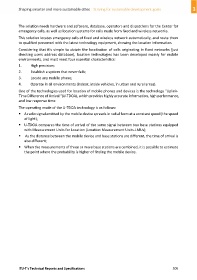Page 319 - Shaping smarter and more sustainable cities - Striving for sustainable development goals
P. 319
The solution needs hardware and software, database, operators and dispatchers for the Center for
emergency calls, as well as location systems for calls made from fixed and wireless networks.
This solution locates emergency calls of fixed and wireless network automatically, and route them
to qualified personnel with the latest technology equipment, showing the location information.
Considering that it's simple to obtain the localization of calls originating in fixed networks (just
checking users address database), location technologies has been developed mainly for mobile
environments, and must meet four essential characteristics:
1. High precision;
2. Establish a system that never fails;
3. Locate any mobile phone;
4. Operate in all environments (indoor, inside vehicles, in urban and rural areas).
One of the technologies used for location of mobile phones and devices is the technology "Uplink‐
Time Difference of Arrival "(U‐TDOA), which provides highly accurate information, high performance,
and low response time.
The operating mode of the U‐TDOA technology is as follows:
A radio signal emitted by the mobile device spreads in radial form at a constant speed (the speed
of light);
U‐TDOA compares the time of arrival of the same signal between two base stations equipped
with Measurement Units for Location (Location Measurement Units‐LMUs);
As the distance between the mobile device and base stations are different, the time of arrival is
also different;
When the measurements of three or more base stations are combined, it is possible to estimate
the point where the probability is higher of finding the mobile device.
ITU‐T's Technical Reports and Specifications 309

